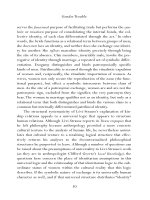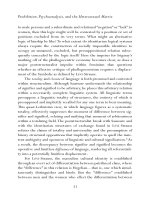GENDER TROUBLE 86
Bạn đang xem bản rút gọn của tài liệu. Xem và tải ngay bản đầy đủ của tài liệu tại đây (20.48 KB, 1 trang )
Prohibition, Psychoanalysis, and the Heterosexual Matrix
to male persons and a subordinate and relational “negation” or “lack” to
women, then this logic might well be contested by a position or set of
positions excluded from its very terms. What might an alternative
logic of kinship be like? To what extent do identitarian logical systems
always require the construction of socially impossible identities to
occupy an unnamed, excluded, but presuppositional relation subsequently concealed by the logic itself? Here the impetus for Irigaray’s
marking off of the phallogocentric economy becomes clear, as does a
major poststructuralist impulse within feminism that questions
whether an effective critique of phallogocentrism requires a displacement of the Symbolic as defined by Lévi-Strauss.
The totality and closure of language is both presumed and contested
within structuralism. Although Saussure understands the relationship
of signifier and signified to be arbitrary, he places this arbitrary relation
within a necessarily complete linguistic system. All linguistic terms
presuppose a linguistic totality of structures, the entirety of which is
presupposed and implicitly recalled for any one term to bear meaning.
This quasi-Leibnizian view, in which language figures as a systematic
totality, effectively suppresses the moment of difference between signifier and signified, relating and unifying that moment of arbitrariness
within a totalizing field. The poststructuralist break with Saussure and
with the identitarian structures of exchange found in Lévi-Strauss
refutes the claims of totality and universality and the presumption of
binary structural oppositions that implicitly operate to quell the insistent ambiguity and openness of linguistic and cultural signification.6 As
a result, the discrepancy between signifier and signified becomes the
operative and limitless différance of language, rendering all referentiality into a potentially limitless displacement.
For Lévi-Strauss, the masculine cultural identity is established
through an overt act of differentiation between patrilineal clans, where
the “difference” in this relation is Hegelian—that is, one which simultaneously distinguishes and binds. But the “difference” established
between men and the women who effect the differentiation between
51









